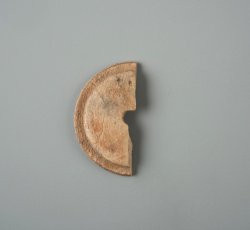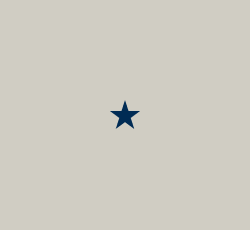Incomplete - Page 9 of 14

2-piece button with wooden back
Wood | Object #: 1788309
This is the hardwood back of a two piece button. In this style of button, the face, or cover, of the button was commonly fashioned from a sheet of thin metal, usually a variety of copper alloy. Backings for these buttons provided both strength and a method of attaching the button to clothing, e...
Explore This Item
Coat button with Sheffield plate silver face.
Copper/Copper Alloy | Object #: 1788365
This is the metal face, or front portion, of a two piece button. In this style of button, a disk of lathed bone with a beveled edge often served as a button back. The face of the button was commonly fashioned from a sheet of thin metal, usually a variety of copper alloy, cut into the approximat...
Explore This Item
2-piece "Death Head" button face with silver/tin plating.
Copper/Copper Alloy | Object #: 1788584
This is the metal face, or front portion, of a two piece button. In this style of button, a disk of lathed bone with a beveled edge often served as a button back. The face of the button was commonly fashioned from a sheet of thin metal, usually a variety of copper alloy, which would be crimped ...
Explore This Item
Carved bone coat button back with beveled edge and one eye.
Bone | Object #: 1789040
Bone button molds were disks cut from animal bone, often identifiable by the presence of a single central hole created by a cutting tool during production. The bone disk often served as core to either a cloth covered or a two part metal button. In cloth covered buttons, the bone mold served as ...
Explore This Item
Carved bone coat button back with beveled edge and one eye.
Bone | Object #: 1789047
Bone button molds were disks cut from animal bone, often identifiable by the presence of a single central hole created by a cutting tool during production. The bone disk often served as core to either a cloth covered or a two part metal button. In cloth covered buttons, the bone mold served as ...
Explore This Item
Carved bone coat button back with beveled edge and one eye.
Bone | Object #: 1789049
Bone button molds were disks cut from animal bone, often identifiable by the presence of a single central hole created by a cutting tool during production. The bone disk often served as core to either a cloth covered or a two part metal button. In cloth covered buttons, the bone mold served as ...
Explore This Item
Carved bone button back with beveled edge and one eye.
Bone | Object #: 1789052
Bone button molds were disks cut from animal bone, often identifiable by the presence of a single central hole created by a cutting tool during production. The bone disk often served as core to either a cloth covered or a two part metal button. In cloth covered buttons, the bone mold served as ...
Explore This Item
Copper alloy two-piece domed waist coat button face and shank.
Copper/Copper Alloy | Object #: 1789053
This is a shattered 2-piece copper alloy button. After conservation, the button shattered into approximately ten fragments and therefore no measurements other than weight was recorded. Notes from prior to conservation indicate the original measurements were as follows: the height of the dome wa...
Explore This Item
Gilded and stamped copper alloy waist coat button with bone back
Copper/Copper Alloy | Object #: 1789382
Heavily corroded and fragmented. Missing its shank. Note on tag says "cannot withstand treatment". Measurements taken from largest metal frag.
Explore This Item
Unidentifiable iron button with shank
Iron | Object #: 1789384
This is the metal back of a two piece button. In this style of button, the face, or cover, of the button was commonly fashioned from a sheet of thin metal, usually a variety of copper alloy. Backings for these buttons provided both strength and a method of attaching the button to clothing, eith...
Explore This Item
Coat button with gilded star pattern of metallic thread.
Metal, unidentifiable | Object #: 1789415
This remarkable artifact is a textile covered button. The star pattern is composed through the careful arrangement of metallic foil strips and metallic coated threads, which have been braided or twisted. The barest hints of the silk core to the threads can be seen in the image, and were preserv...
Explore This Item
Copper alloy domed collar button with concentric ring design.
Copper/Copper Alloy | Object #: 1789441
Identical to shank of incomplete collar button 1796770. Measurements slightly off due to conservation. Copper alloy face filled with pewter on the interior to connect stud with face.
Explore This Item
Copper alloy flat disc coat button.
Copper/Copper Alloy | Object #: 1796817
On display at the International Museum of Slavery, Liverpool. Catalogued from drawings.
Explore This Item
Copper alloy button ring button, medium.
Copper/Copper Alloy | Object #: 1800019
This ring is a simple length of copper alloy wiring which is soldered to form a circular core upon which thread or textile swatches were stretched to create cloth covered buttons. Often, extra fabric material was gathered at the rear to serve as a shank to attach the button to items of clothing...
Explore This Item
Copper alloy button ring, small, with preserved thread impression around frame.
Copper/Copper Alloy | Object #: 1800055
This ring is a simple length of copper alloy wiring which is soldered to form a circular core upon which thread or textile swatches were stretched to create cloth covered buttons. In this example, the corrosion of the copper alloy has preserved the impressions of the threads that once were used...
Explore This Item
Partial tinned singleton button, small.
Copper/Copper Alloy | Object #: 1800268
2 fragments. Diameter around 11.8mm
Explore This Item
Tombac coat button with shank cast in boss.
Tombac | Object #: 1800311
This is a one piece metal button, which archaeologists often refer to as “flat disc” buttons. One piece buttons were often made of copper alloys. This particular example is cast tombac as denoted by the “grey” coloration seen below the corrosion on the button face. Tombac is an alloy of copper ...
Explore This Item
Copper alloy button ring, small.
Copper/Copper Alloy | Object #: 1802408
This ring is a simple length of copper alloy wiring which is soldered to form a circular core upon which thread or textile swatches were stretched to create cloth covered buttons. Often, extra fabric material was gathered at the rear to serve as a shank to attach the button to items of clothing...
Explore This Item
Copper alloy button ring, small.
Copper/Copper Alloy | Object #: 1802412
This ring is a simple length of copper alloy wiring which is soldered to form a circular core upon which thread or textile swatches were stretched to create cloth covered buttons. Often, extra fabric material was gathered at the rear to serve as a shank to attach the button to items of clothing...
Explore This Item
Copper alloy button ring, small.
Copper/Copper Alloy | Object #: 1802415
This ring is a simple length of copper alloy wiring which is soldered to form a circular core upon which thread or textile swatches were stretched to create cloth covered buttons. Often, extra fabric material was gathered at the rear to serve as a shank to attach the button to items of clothing...
Explore This Item